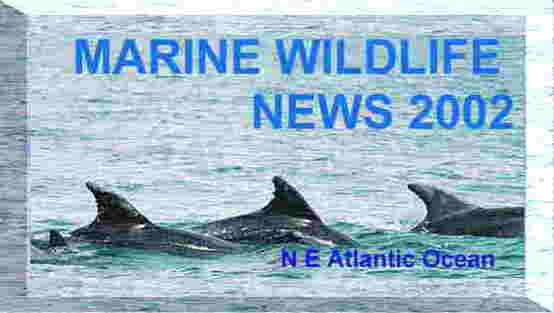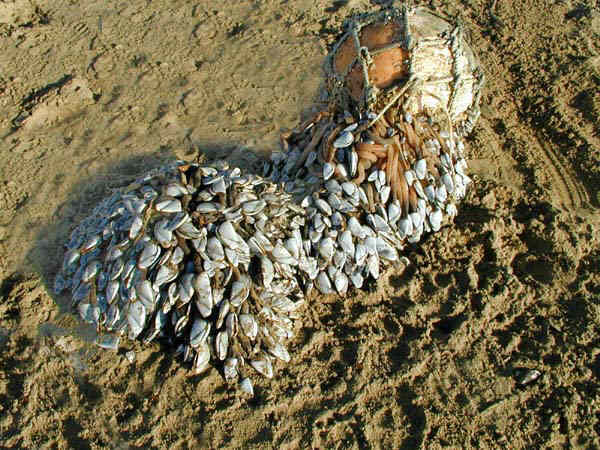
|
|
|
|
|
(BMLSS *** Site) |
|
|
|
Norwegian Marine*** |
|
L-I-N-K-S to Other Sites (Click on Text) |
|
How to Join |
|
|
|
|
|
Recommended Sites |
|
|
|
|
|
|

Monthly Marine News Bulletin |
|
Marine Nature Conservation Review Survey Database |
|
|
 |
|
|
|
|
|
|

.
MARINE LIFE NEWS
Reports of marine wildlife from all around the British Isles, with pollution incidents and conservation initiatives as they affect the fauna and flora of the NE Atlantic Ocean.
on Microsoft Internet Explorer (best) or Netscape
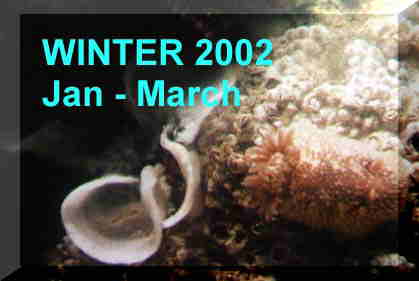 |
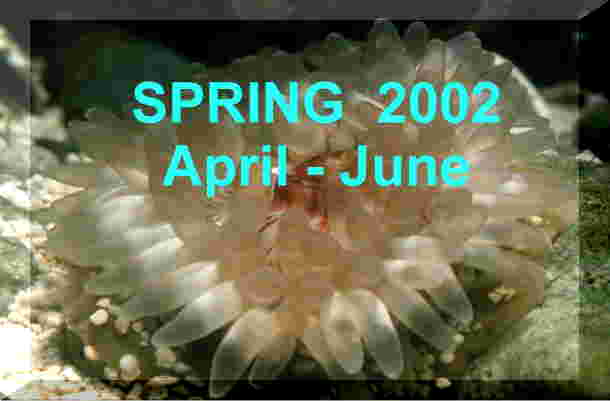 |
 |
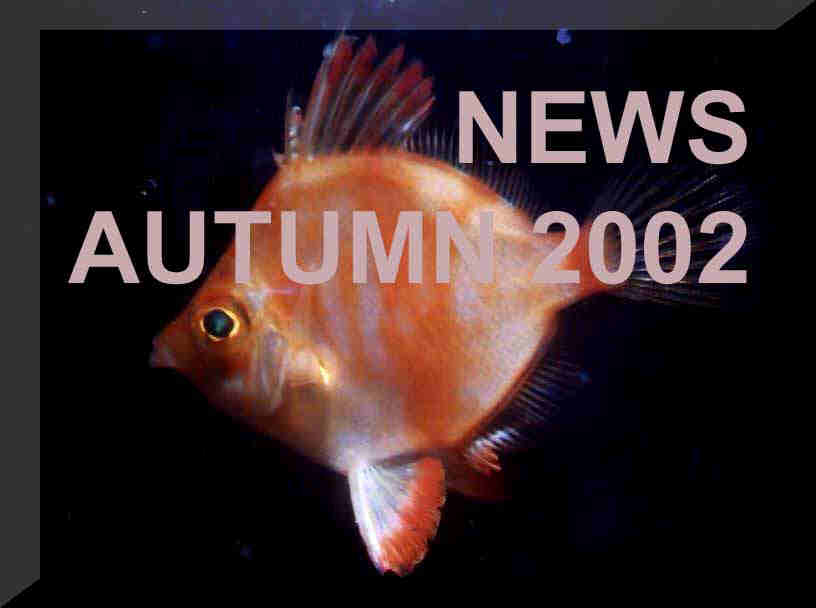 |
- LATEST
NEWS
30
March 2002
The
small patch of loose sponge-covered flint rocks with small bits of chalk
at Lancing beach, Sussex, proved
unusually rich in small rockpool life at the
very low tide (TQ
018 034). The
discoveries included a Pimplet
Anemone, Anthopleura ballii, another anemone
species that has never been recorded this far east before.
28
March 2002
A
Bottle-nosed
Dolphin,
Tursiops truncatus, has
been seen in Weymouth Harbour, and it is believed to have followed a trawler
through the narrow inlet.
Weymouth
News Report
Durlston
Wildlife Update
23
- 24 March 2002
A
pod of between 30 and 40 Pilot
Whales,
Globicephala melas, became stranded, or nearly stranded,
at near Camp in North in Tralee Bay, County Kerry, Ireland, and were prevented
from beaching and helped back out to sea. 18 of these whales (actually
dolphins with a bottle-shaped head) perished, but many were coaxed back
into the sea on the first day. On the following day, 10 to 12 whales were
spotted the shallow water of Fenit Harbour, but they did not become beached
and the Fenit lifeboatmen were able to escort them back into deeper water.
BMLSS Cetaceans
22
March 2002
A
pod of six Killer Whales,
Orcinus
orca, are seen from the Fetlar ferry in the Shetland Isles. (Fetlar
is an island in the north-east of the Shetlands.)
21
March 2002
About
twenty dead Lesser Octopuses, Eledone cirrhosa, were
scattered over a stretch of about 200 metres of Killiney beach, Co. Kerry,
Ireland.
20
March 2002
Vernal
Equinox at 19:03 GMT (UT).
c.
18 March 2002
A
badly composed whale is washed up on Saligo Bay (NR
209672) on the west coast of Islay, Argyll,
the outermost island of the Inner Hebrides. The whale has been identified
(needs to be confirmed) as Cuvier's
Beaked Whale, Ziphius cavirostris, which is a deep water whale
rarely seen alive and rarely washed up on the most westernmost shores of
Britain and Ireland.
News: Cuvier's Beaked Whale (Co. Sligo, Ireland 2000)
18
March 2002
After
a few days of gales a large standing of Common
Cuttlebones, Sepia elegans, is
a reasonably common on Cornish shores. However, the stranding of over 100
cuttlebones on Polperro beach, south Cornwall included seven specimens
of the rarer species Sepia orbignyana.
Cuttlefish Pages (Matt Stribley)
17
March 2002
Thousands
of Common Starfish,
Asteria
rubens, are washed up on the beach at Holkham, Norfolk, on the east
coast of England after sustained north-easterly gales.
c.
14 March 2002
After
a sustained period of north-easterly gales, there was a massive
stranding of marine animals and weed on the Yorkshire shore (north-east
England) between Fraisethorpe and Barmston (East Yorks: Holderness).
The most noticeable of the animals washed up were hundreds of thousands
of
starfish mostly of the Common
Starfish,
Asteria rubens, but
other species were present. The list of interesting animals washed up included
decapod
crustaceans
including Lobsters that were still alive,
crabs
etc., a wide variety of fish, sea
anemones,
polychaete worms, molluscs
including octopuses,
porpoises,
seals
and tonnes of seaweed. This is the largest stranding
recording on these web pages.
Strandline & Beachcombing Page
12-
26 February 2002
After
a few days of gales, Goose Barnacles, Lepas anatifera, have
been washed ashore on the shores of Cornwall and south Wales and probably
elsewhere.
BMLSS
Barnacle Page
22-23
February 2002
 A
Boar
Fish,
Capros aper,
was brought up in a net set for Red Mullet,
Mullus
surmulatus, at 12 metres off the island of Guernsey in the Channel
Islands. The Boar Fish
is rarely caught because it is small (59 grams and a total length of 153
mm) and escapes the nets and because it usually lives at greater depths
than most nets are set. The same fisherman caught a Tadpole
Fish, Raniceps raninus,
the day before. This latter fish is widely distributed but solitary for
most of its life so again it is rarely caught.
A
Boar
Fish,
Capros aper,
was brought up in a net set for Red Mullet,
Mullus
surmulatus, at 12 metres off the island of Guernsey in the Channel
Islands. The Boar Fish
is rarely caught because it is small (59 grams and a total length of 153
mm) and escapes the nets and because it usually lives at greater depths
than most nets are set. The same fisherman caught a Tadpole
Fish, Raniceps raninus,
the day before. This latter fish is widely distributed but solitary for
most of its life so again it is rarely caught.
Previous Sussex Record of a Boar Fish
18
February 2002
A
massive stranding of between
120 and 150 Common Dolphins, Delphinus delphis, occurred on
the beach at Pleubian on the Côtes d'Armor, Bretagne (Britanny),
on the English Channel (le Manche) coast of northern France. This stranding
occurred at 3:00 pm just before the low spring tide.
According
to people who witnessed the event on this sandy shore, the first dolphin
beached itself followed by its congeners.
This prompted a rescue by the Fire Brigade, the Police and the public who
were able to help 20 of the unfortunate dolphins and actually lift them
up and put them back into the water. Unfortunately despite strenuous efforts
48 dolphins perished, but about 90 survived.
The
reason for the stranding is not known but the topography of the bay and
the large tidal range were probably contributory.
Map
Original notification by Liz Sandeman (Marine Connection)
Report Numbers for Stranded Cetaceans
Mass Stranding Exercises in Scotland
British Divers Marine Life Rescue
Zoonosis (Marine Mammals)
9 February
2002
After
a week of gales, the Mantis Shrimp illustrated
was discovered on the tideline at Calshot Spit, Hampshire. It is probably
Rissoides
desmaresti.
Crustacean Image Portfolio
Crustacean News Reports
(Marine Wildlife of the North-east Atlantic Ocean Group - members only)
Ivory
Gull investigating a dead Harbour Porpoise as a food source
on
Blackrock Sounds, northern Cardigan Bay, north Wales
Photograph
by Kelvin Jones
- A
Harbour
Porpoise,
Phocoena phocoena, was
washed up dead on Blackrock Sands near Morfa Bychan near Portmadoc in north
Wales. This itself is not a particular unusual event in view of the hundreds
of dolphins washed up dead on English Channel coasts. Porpoises are common
in the north of Cardigan Bay and used to get caught up in fixed nets before
the fishery was halted.
Ivory
Gull feeding on the carcass on 10
February 2002
Photograph
by Chris Galvin
However,
this porpoise was graced by a visit by an Ivory
Gull,
Pagophila
eburnea, an nearly all-white Arctic species
which may have been blown further south by the recent storms. This gull
is a very rare vagrant to Wales and England.
Pictures
on the Surfbirds News Page
Bird
species recorded in Great Britain
5 February
2002
Cetacean
Deaths
Large
numbers of dolphins are washed up dead on the French coast with reports
of about 300 deaths. The French newspapers showed the dolphin carcasses
piled up high on the beach.
(In previous years the numbers have been recorded at 26.)
1
February 2002
Gales
batter the coasts of Britain, coinciding with exceptionally high tides,
resulting in localised flooding, with the strongest winds across lowland
Scotland.
Beaufort
Scale (sea)
Beaufort
Scale (land)
Beaufort
Scale (BMLSS)
January
2002
At
least 50 small cetaceans,
mostly dolphins, have been washed dead up on English Channel coasts during
this month. Dolphins are washed up dead every year, but there seems to
be at least double the normal numbers this year. Although, the cause of
death is not known for sure, most people seem to think that fishing activities
are to blame. The cause of the increase is less clear; it could be because
of the bad weather has washed more ashore, it could be because more are
being caught because of increased dolphin numbers, or increased fishing
effort, or it could be because more people are reporting their grisly discoveries.
The
largest numbers of cetaceans are washed up on westerly coasts, notably
Cornish shores, but the strandings stretched as far east as the Isle of
Wight and Sussex where an intact Porpoise was cast ashore as well as a
decomposed dolphin.
More
information can be found on the following efora:
Marine
Mammals of the English Channel Smart Group
UK
Cetnet
Cornish
Wildlife Mailing List
Marine
Wildlife of the North-east Atlantic Ocean Group
New
born
Bottle-nosed Dolphin
with adult, 19 May 2001,
swimming against flood tide, and shallow water
Photograph
by Nicolas Jouault, Jersey
BBC
News Report
Report
Numbers for Stranded Cetaceans
BMLSS
Cetacean Page
Sea
Watch Foundation
Cornish
Marine Wildlife Reports 2001 (by Ray Dennis)
European
Cetacean Bycatch
Whale
& Dolphin Society Report & References
19
January 2002
A
Cuckoo Ray, Raja naevus, was discovered in a rock
pool in Cove Harbour , Berwickshire, SE Scotland by Ben
Tindall, Harbourmaster. It was an adult full
grown specimen at 60 cm. The shallow water species of ray is rarely recorded
in pools, although the Thornback Ray, Raja clavata, has been recorded
in very shallow water in February in the English Channel. The Cuckoo Ray
has not been extensively studied. It is a southern species found
all around Britain and in the Mediterranean Sea and it lays its egg cases
all through the year with possibly a peak in January. This ray could have
found its way into the rock pool as a result of fishing activities. This
ray
is common off this North Sea coast and has been recorded in harbours before.
11
January 2002
Dogwhelks
lay eggs after a 25 year absence
Kingston
Beach, Shoreham Harbour, Sussex.
A
notable discovery were large Dogwhelks,
Nucella
lapillus, averaging 50 mm in length (all a dirty white colour) and
one group were laying their egg capsules. This was unknown on this shore
since the TBT pollution wiped out
the breeding population in the 1970s. A chemical component called tributyltin
in anti-fouling paints caused female Dogwhelks to develop a condition called
imposex which prevented them from breeding.
Full
Report
Dogwhelk
page
Trouble
with Dogwhelks
6 January
2002
Donny
Nicolson reported a decomposed Leatherback
Turtle, Dermochelys coriacea, washed ashore on the Dale beach
at Walls (west Mainland) in the Shetland Isles.
British Marine Turtle Stranding Network
3 January
2002
A
2.88 metres long female Pygmy Sperm Whale,
Kogia
breviceps, was washed up dead on Thurleston Beach in Devon. This is
an extremely unusual stranding of a deep sea whale. Scientists from the
Natural History Museum in London have taken DNA samples in an attempt to
discover from which population this whale came from. The cause of death
was unknown. This species is much commoner in the southern hemisphere.
The presence of a population west of the Bay of Biscay is possible. This
whale is classified as a Vagrant in the British
Cetacean List.
via the Marine Mammals of the English Channel Smart Group
Natural History Museum Department of Zoology
National Whale Stranding Recording Scheme (includes excellent photographs)
Further Details
BMLSS Cetacean Page
3 January
2002
A
deep water trawler after Blue Ling and Hake etc. caught a female Giant
Squid, Architeuthis dux, amongst the large haul of fish. With
a mantle length of 127 cm it is a medium-sized specimen with some of the
tentacles missing. Therefore, the total length could not be measured, but
it is estimated to be about 5.5 metres with a weight of about 60 kg. the
specimen will be prepared for display at the National
Marine Aquarium, Plymouth, ‘Creatures of the Deep' zone from
May
2002.
This
is believed to be the 25th Architeuthis recorded in British waters
since 1673.
via the Marine Wildlife of the North-east Atlantic Ocean Group
Aberdeen University Giant Squid site (by Dr Martin Collins)
BMLSS Octopuses and Squids
2 January
2002
An
empty fuel tanker "Willy" becomes stranded on rocks off Kingsand, near
Plymouth, Devon. This is a small 3000 tonne cargo vessel with 100 tonnes
of fuel oil. Leaking fuel poses a threat to a Site of Special Scientific
Interest (SSSI) off the coast at Cawsand. However, the main concern is
that the ship will explode if the fuel vapours are ignited.
BBC
News Report
Oil
Tanker Disasters: Oiled Bird Count
1 January
2002
More
Triggerfish,
Balistes
capriscus, are washed up dead on Cornish shores. The Hocking
family (Sue, Richard, Emma and Rebecca) found
eight Triggerfish on Porthtowan beach, Cornwall.
Reports
from Stella Turk (Link)
Previous
Report
21
December 2001
A
Slipper
Lobster, Scyllarus arctus, was caught in a lobster pot at a
depth of about 60
metres
about 3 miles south east of St Mary’s, Isles of Scilly , just before Christmas
by Barry Bennett. Realising
that it was an unusual and interesting find Barry put it in a display tank,
which he maintains in the Harbour Master’s Office in St Mary’s.
Scyllarus
arctus is a warm waters species found in the Mediterranean, and in
the Eastern Atlantic from Morocco to the English Channel but is rare north
of the Bay of Biscay. They live on stony ground, in caves, and can
also be found on muddy bottoms or in seagrass beds. They use the
large spade-like scales at the front of the head to burrow into mud,
sand
or gravel between and under stones. Only 15 have been confirmed from British
seas all from off Cornwall, the Isles of Scilly or off Plymouth.
Full
Report
Full
Report (CD-ROM only)
FOR EARLIER REPORTS CLICK ON THE BUTTON BELOW

The Marine Wildlife of the NE Atlantic Forum.
PLEASE JOIN

MARINE WILDLIFE of the NE ATLANTIC EFORUM PAGE (LINK TO)
Shetland Wildlife
News & Information on the Wildlife of Shetland http://www.wildlife.shetland.co.uk/Cornish Wildlife
Vince Smith's Cornish Mailing List
Send a message to the list at: CornishWildlife@onelist.com
News 2000
News 1999
|
Use these links if your are familiar with the scientific classifications of marine life |
The BMLSS (England) site commenced on 1 January 1997.
|
|
 |
 |
Andy Horton, Webmaster
|
|
|
|
|
|
Membership Form |
News 2000 |
